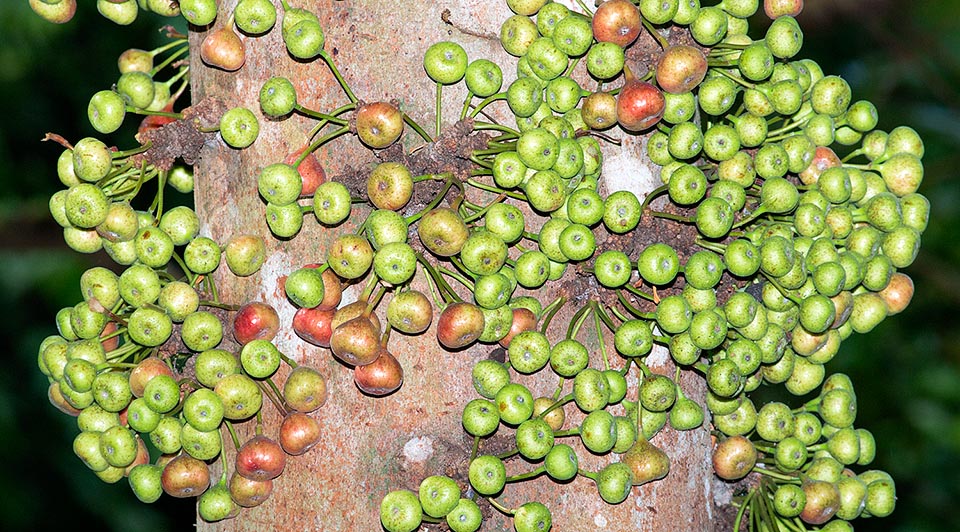Family : Moraceae

Text © Pietro Puccio

English translation by Mario Beltramini

Ficus variegata is a South East Asian species that in nature exceeds the 30 m of height © Giuseppe Mazza
The name of the genus is the Latin one utilized for the Common fig (Ficus carica); the specific one is the Latin adjective “variegatus, a, um” = variegated, with reference to the colour of the fruits.
Common names: common red-stem fig, green-fruit fig, variegated fig (English); za se rong (China); tangisang bayawak (Philippinas); giran-inu-biwa (Japan); gele, gondang, nyawai (Indonesia); kayu, pahobo (Sulawesi); phuuk (Thailand); sung trổ, sung vè, vả rừng (Vietnam).
The Ficus variegata Blume (1825) is an evergreen or deciduous for short period tree, dioecious, usually up to about 15 m tall, but the old specimens in nature may exceed the 30 m, with erect trunk up to more than 1 m of diameter endowed at the base of tabular roots (flattened roots similar to buttresses) and smooth bark of grey-brown colour; from the wounds exudes an abundant milky sap.
The leaves, on a 2-6,5 cm long petiole, are alternate, simple, ovate-elliptic with entire margin, wavy or lightly toothed, obtuse or acuminate apex and prominent veins, coriaceous, 10-25 cm long and 5-15 cm broad, of intense green colour above, pale below; deciduous stipules (appendages at the base of the leaf that have the main purpose of protecting it during the initial phase of growth), ovate-lanceolate, glabrous or slightly pubescent, 1-1,5 cm long.
The inflorescences are hollows with flesh walls, called syconia, that enclose wholly the flowers, accessible through an apical opening wrapped by 3 tiny scales. The syconia, grouped on short tuberculate branches on a 2-4 cm long peduncle, arise on the stem and the old branches devoid of leaves (cauliflory), are globose, depressed globose or pyriform, of 2-3,5 cm of diameter, of red colour with pale green stripes and spots when ripe, with male and female flowers on different individuals; the tiny fruits (achenes) contain only one seed. The pollination is done by an insect belonging to the family of the Agaonidae, in our case Ceratosolen appendiculatus Mayr, 1885, as known to each species of Ficus is associated a specific insect, that in its turn may reproduce only in presence of the species to which it is associated.
The fruits, produced abundantly and continuously during the year, are an important source of food for various birds and mammals of the forest, among which some primates, that contribute to the dispersion of the seeds.
It propagates by seed, planted superficially on organic substratum, sandy, maintained constantly humid at a temperature of 24-26 °C; it reproduces also by tip cutting in spring and air layering in early summer.

The syconia, grouped on short 2-4 cm peduncles, arise on the stem. The fructification, generous and almost continuouortant source of food for the forest animals that contribute to the dispersion of seeds. The dried fruits are at times consumed with rice also by local populations. Leaves and bark display therapeutic virtues © G. Mazza
Synonyms: Ficus cordifolia Blume (1825); Ficus subracemosa Blume (1825); Ficus racemifera Roxb. (1832); Ficus amboinensis Kostel. (1833); Ficus laevigata Blanco (1837); Covellia racemifera (Roxb.) Miq. (1848); Ficus cerifera Blume (1855); Ficus ceriflua Jungh. (1853); Ficus subopaca Miq. (1859); Ficus chlorocarpa Benth. (1861); Ficus domestica Zipp. ex Miq (1867); Ficus gummiflua Miq. (1867); Ficus sycomoroides Miq. (1867); Ficus ehretioides F.Muell. ex Benth. (1873); Ficus integrifolia Elmer (1906); Ficus latsonii Elmer (1906); Ficus paucinervia Merr. (1906); Ficus garciae Elmer (1908); Ficus konishii Hayata (1911); Ficus glochidiifolia Hayata (1919); Ficus tenimbrensis S.Moore (1925); Ficus sum Gagnep. (1927); Ficus viridicarpa Corner (1933); Ficus compressitora Elmer (1937); Ficus ilangoides Elmer (1937); Ficus agusanensis Elmer (1939).
→ To appreciate the biodiversity within MORACEAE family and find other species, please click here.
